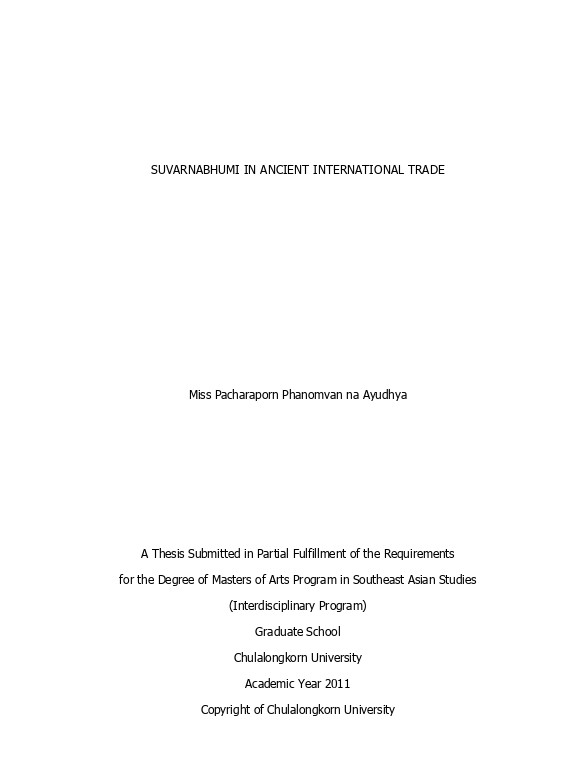|
|
|
|---|

| ผู้เขียน | Pacharaporn Panomwon Na Ayutthaya |
| ชื่อวิทยานิพนธ์ | Suvarnabhumi in ancient international trade |
| มหาวิทยาลัย | Chulalongkorn University |
| คณะ | Graduate School |
| สาขาวิชา | Southeast Asian Studies |
| ระดับการศึกษา | ปริญญาโท |
| ปี | 2554 (2011) |
| จำนวนหน้า | 125 |
| ภาษา | English |
| ที่มา | ลิงก์ที่มา |
Abstract (Thai)
Abstract (English)
Acknowledgments
Contents
List of Tables
List of Figures
Chapter I Introduction
Research Question
Hypothesis
Limitations of Study
Research Process and Methodology
Chapter II Literature Review
Chapter III Terminology, An Identity from Trade Networks
Characteristics of Southeast Asia and its History
Indic Literatures
Chinese Literatures
Classical Literatures
Chapter IV Identity, Commodities, and Economic Wealth
Spices
Ores and Minerals
Bronze Drums
Commodities, Beads, and Development
Beads
Technology transfer and trade
Ships and Seafaring technology
Chapter V Analysis and Discussions
Economic Wealth and Trade
Economic Worth
Conclusion and Discussions
References
Appendices
Appendix A Naps of the Ancient World
Appendix B MAps of Ancient Trade Routes
Appendix C Artefacts
Biography
Abstract (Thai)
Abstract (English)
Acknowledgments
Contents
List of Tables
List of Figures
Chapter I Introduction
Research Question
Hypothesis
Limitations of Study
Research Process and Methodology
Chapter II Literature Review
Chapter III Terminology, An Identity from Trade Networks
Characteristics of Southeast Asia and its History
Indic Literatures
Chinese Literatures
Classical Literatures
Chapter IV Identity, Commodities, and Economic Wealth
Spices
Ores and Minerals
Bronze Drums
Commodities, Beads, and Development
Beads
Technology transfer and trade
Ships and Seafaring technology
Chapter V Analysis and Discussions
Economic Wealth and Trade
Economic Worth
Conclusion and Discussions
References
Appendices
Appendix A Naps of the Ancient World
Appendix B MAps of Ancient Trade Routes
Appendix C Artefacts
Biography
This thesis reassesses the mainstream historical approach towards the lands referred to as Suvarnabhumī and Suvarṇadvīpa by focusing on expanding the picture of early settlements in Southeast Asia that was triggered by maritime trade in the Bay of Bengal and the Southern Silk Road. The concept and existence of “Suvarnabhumī” as an entity has always been both disputed and uncertain. More conservative historians have treated it as a mythological entity that only exists in the minds of Ancient Indic travellers. Yet, both tales and factual accounts from Chinese, Ancient Greek and Indians literatures have emerged in reference to the lands known as “India beyond the Ganges”, and its highly priced resources. Traded goods reflect socio-economic factors of the destination or port the goods flow through, especially its variety and density. Moreover, it reflects exposure and variety of religious and cultural values that are transferred along with commodity demands. The traditional perspective on the sole influences of India towards the emergence of latter advance cultures within Southeast Asia is bought into question with the style inspiration from the Egyptian and Greek civilisation in ports within the Ganges, which accumulated immense wealth from maritime trade. The thesis re-evaluates the identity of Suvarnabhumī in ancient international trade by using ancient trade records and seafaring accounts by ancient Indian travellers, Pliny, and Ptolemy, as well as archaeological evidences such as international trade items production and movement found within Southeast Asia and the Southern Silk Road. Among these are economic regulations and technology that possibly stimulated the emergence of Early States in Southeast Asia and the Bay of Bengal. Economic operations from and to Suvarnabhumī and Early Southeast Asia define its identity and capital wealth, which laid grounds for large maritime cultures that operated as trading gateways such as Sri Vijaya and Dvaravati.